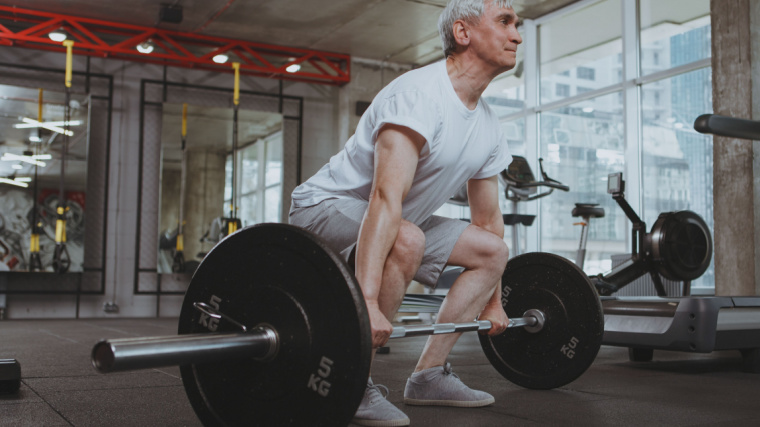“Doubling up” can be a good thing — A doubleheader at the ballpark, double meat in your burrito bowl, and a double shot of espresso to jump-start the day. But it can also be, well, double trouble — Double vision, double traffic fines, and double-dipping your chip at a party.
But how about doubling up on big lifts in the same workout with deadlifts after squats? Or maybe deadlifts before rows? The question of whether to put the deadlift on “leg day” or “back day” is a contentious programming issue.

Put deadlifts on leg day, and you’re likely combining squats and deadlifts in the same workout. Not exactly a walk in the park, especially considering the heavy loads typically used with these big lifts. Instead, you could slip deadlifts alongside upper body exercises like barbell rows, but now you’ve created a daunting “pull” session with the potential to fry your back.
Before you double-down on any program design biases, consider the potential pros and cons. Explore the root of this question, delve into scientific evidence, and find practical recommendations to solve this lifting conundrum.
Deadlift on Back Day or Leg Day?
- Overview of Training Splits
- Muscles Worked by the Deadlift
- Effects of Intra-Workout Fatigue
- Strategies to Manage Intra-Workout Fatigue
- Recovery Between Workouts
- Programming the Deadlift for Strength
- Programming the Deadlift for Hypertrophy
Overview of Training Splits
Most lifters, particularly those training three more times per week, commonly organize their routine using some type of training split. I wrote extensively about the most popular training splits. In brief, a “split” assigns a specific focus to each session of the week. Two of the most common training split routines are Push/Pull/Legs (PPL) and body part (BP) split.
In PPL split routines, lifters hit the gym three or more times per week. The first session (“push day”) is traditionally dedicated to upper body pushing exercises (e.g. overhead press, triceps extensions, or dips). The next session (“pull day”) is reserved primarily for upper body pulling exercises (e.g. rows, pull-ups, or curls). In essence, “pull day” is a “back day.” Lower body exercises are typically assigned to the third session (“leg day”).
In BP split routines, lifters hit the gym at least five days per week. As the name suggests, each workout in a BP split is assigned its own muscular region of focus. An example of a common BP follows: “Chest day,” which invariably falls on Monday for typical gym-goers, includes exercises targeting the pectoral muscles (e.g. bench press, incline bench, or pec flye). “back day” includes exercises targeting the muscles on the back of the torso (e.g. lat pulldowns, rows, or back extensions).

“Leg day,” often the most (or least) favorite session of the week, is reserved for lower body exercises such as squats, leg press, leg extensions, leg curls, and calf raises. Direct training for the arms (e.g. plenty of biceps curls and triceps pushdowns) occurs on “arm day.” Finally, “shoulder day” includes overhead pressing variations, lateral raises, upright rows, and other exercises focused on the deltoids.
The Deadlift Dilemma
So, where does the deadlift fit in?
At face value, the deadlift appears to primarily train the hips and lower body. Therefore, the deadlift belongs in “leg day” of PPL and BP split routines. Done and dusted, right?
Better loosen your lifting belt, because it’s not that simple. Categorizing deadlifts in a split routine is a complex question. Its implications may affect the productivity of your training. We need to consider functional anatomy, the potential effects of fatigue, implications for recovery, individual fitness goals, and more.
Muscles Worked by the Deadlift
The deadlift involves lifting a weight, typically a loaded barbell, using a hip-dominant lower body extension pattern. Although many variations of the deadlift exist, all deadlifts require resisted hip extension, which trains the glutes, most of the hamstrings, and some of the inner thigh muscles. Primary muscles include: gluteus maximus, gluteus medius, gluteus minimus, semimembranosus, semitendinosus, biceps femoris (long head), and adductor magnus.
Above the hips, the trunk muscles must keep the body ridged and transfer forces generated by the hips to the upper body. “Spinal erectors” refers to muscles on the backside of the trunk that act to extend the spine — The erector spinae muscle group, quadratus lumborum, the semispinalis group, and many smaller muscles fall into this category. Mechanically, the spinal erectors are the most significant trunk muscles during the deadlift. Albeit, the abdominal muscles are also essential, as they contract along with the spinal erectors to increase pressure in the abdomen, which further increases the rigidity of the trunk.

Depending on the deadlift variation employed (e.g. conventional versus Romanian), the quadriceps may be more or less involved. Finally, the forearm muscles involved in grip are also active in the deadlift.
The deadlift works the entire posterior chain, including muscles in the legs and back. Clearly, the deadlift does not fit cleanly into either “leg day” or “back day.” But organizing your training split was never about goose-stepping to rules about which body parts can be trained on which day. Your splits should promote the desired training adaptation, such as strength or muscle size. If you want to experience ongoing increases in strength and size, you’ll need to manage fatigue within each workout then recover for the next one.
Effects of Intra-Workout Fatigue
Fatigue, technically, describes the reduction in a muscle’s ability to contract or produce force. Two types of fatigue occur in response to exercise: peripheral fatigue and central fatigue. Peripheral fatigue occurs at the working muscles, while central fatigue occurs because of processes at the brain and spinal cord. (1)
To be clear, fatigue is an inextricable part of hard training. Peripheral and central fatigue amass simultaneously as we train. Put deadlifts on “leg day,” and fatigue from deadlifts may negatively affect other lower body exercises on “leg day,” and vice versa depending on your exercise order. Hit deadlifts on “back day,” and fatigue from deadlifts may negatively affect other back exercises (and again, vice versa).
While no coach or study can definitively tell you which programming option will work best for you, we can explore the effects of fatigue on postural stability, the potential for injury, and exercise adaptations.
Fatigue and Postural Muscle Stability
Deadlifts, squats, and rows, such as bent-over barbell rows and unsupported dumbbell row variations are considered structural exercises because they place load through the trunk. Structural exercises are typically compound, or multi-joint, movements and tend to be programmed toward the beginning of the workout.
A concern when programming multiple structural exercises in the same workout is the potential for trunk muscle fatigue. A lifter who exhausts the muscles that support the trunk may be less able to maintain stability during subsequent exercises. Moreover, it has been suggested that fatigue of the trunk muscles may predispose a lifter to injury during subsequent lifts. (2)(3)

So, how do trunk muscles respond to fatigue induced by deadlifts?
Strang and Berg compared a well-rested control group to folks who performed deadlifts to failure. The researchers measured postural muscle activity and postural stability in response to a lateral raise. (4) Postural stability did not differ among the fresh- and fatigued participants. However, the fatigued participants demonstrated earlier onset of trunk extensor (lower back) and hamstring muscle activity. (4)
These findings illustrate the nervous system’s ability to compensate for fatigue by changing the timing of muscle contractions. Relative to the trunk-fatigue question, this study has several limitations. Although the study appears to support training deadlifts on “shoulder day,” it does not directly address our question of how deadlifts affect stability subsequent heavy “back day” or “leg day” performance.
Another study may be more generalized, exploring scenarios when deadlifts are performed before other structural exercises (e.g. squats or bent-over rows). Healthy participants performing fatiguing deadlifts followed by structural loading via standing with 25% of bodyweight in a weight vest. (2) Trunk extensor muscle activity remained similar to unfatigued condition, but abdominal muscle activity decreased following deadlifts. (2)
Altogether, it appears the body compensates for deadlift-induced fatigue by activating muscles earlier and maintaining activity of trunk extensors, but changes in coordination patterns between trunk extensors and abdominals may occur during subsequent exercises.
To be clear, no definitive link between deadlift-induced fatigue and injury risk has been established. However, Breton and McGill have suggested random movement errors may result in injury. Fatigue may increase the rate of errors, albeit with a high degree of individual variability. (3)
Fatigue and Exercise Adaptations
Adaptations to exercise tend to be blunted when training is performed in a fatigued state. (1)(5) Peripheral fatigue and central fatigue reduce the force produced by working muscles. (1) Active muscle force is a component of mechanical tension, which is likely a key driver of muscle growth. (6) Ultimately, reduced force output due to fatigue could lead to less muscle gain.
Fatigue might be an even greater enemy for those interested in building strength. According to a meta-analysis by Nunes and colleagues, the lifts performed last in the workout result in reduced strength improvements compared to those performed first. (7) The negative influence of fatigue is thought to underlie this phenomenon. (5) Fatigue cannot be avoided during hard training, but it can be managed. Managing fatigue is a priority in solving our “deadlift dilemma.”
Strategies to Manage Intra-Workout Fatigue
When programming the deadlift, it’s prudent to scrutinize your own fatigue response. Due to individual variations in fatigue and its effects, a bit of self-reflection may be in order. Here are some common scenarios and potential action plans to guide your decision-making.
Deadlifting Delivers a Massive Low Back “Pump”
You might experience disproportionate peripheral fatigue in the spinal erectors (lower back). If you put deadlifts on “leg day,” you might be better off following them up with supported exercises, such as leg press or leg extensions instead of squats, and choosing hamstring curls rather than good mornings.
If you choose to put deadlifts on “back day,” bench-supported rows, pull-ups, and pulldowns are all great options that spare your spinal erectors.
Deadlifts Hammer Your Hamstrings More Than Anything
In this scenario, hamstrings experience the lion’s share of peripheral fatigue. You could embrace this and use the deadlift as your primary hamstrings exercise on “leg day.”
On the other hand, programming deadlifts on “back day” may be a great option for you. This provides an opportunity to train hamstrings with non-deadlift exercise of your choice on leg day and potentially increase your overall weekly hamstring-training volume. This strategy of adding volume may be effective if your recovery is on point.
Simply “Fried” After Deadlifts
If you notice big drops in your performance of other lifts after a few sets of deadlifts, central fatigue may be overriding. Central fatigue is the type that affects exercised and non-exercised muscles. (1) So, it is likely to affect subsequent back or leg exercises.
Perhaps counterintuitively, central fatigue has been shown to be greater following lower load exercises to failure than higher load exercise to failure. (8) Therefore, adjusting deadlift intensity and volume might be useful. Favor fewer sets and repetitions with heavier loads. To address whether to pair deadlift with “back day” exercises or “leg day” exercises, consider placing deadlifts in the lower volume workout of the two — The one that tends to have fewer total sets and reps.
Recovery Between Workouts
The deadlift has a reputation for producing lingering fatigue, delayed onset muscle soreness, and general malaise after a hard session. But is this reputation justified?
Contrary to popular lore, there is reason to believe the deadlift may be the most “recoverable” of the three powerlifts — Squat, deadlift, and bench press. Belcher and colleagues took athletes through workouts including four sets to failure of a single powerlift with 80% of one-repetition maximum. They showed reduced mean concentric (lifting) velocity, or bar speed, for the squat and bench press at 24-, 48-, and 72 hours postworkout; but the bar speed of the deadlift was not significantly slower than in the initial workout. (9)

Delayed onset soreness was present and similar at all three timepoints following each of the three powerlifts. However, cell-free DNA concentrations — an indicator of muscle damage in this context — increased for bench press and squat following the rigorous workout, but not for deadlift. (9) These data indicate deadlifts may be more recoverable, in some ways, than the squat or bench press.
Although the deadlift may not be the full-on menace to recovery many may have thought, it has the potential to impose substantial recovery demands. One major limitation to the Belcher study is it did not measure low back soreness or range of motion. Anecdotally, high-intensity or high-volume deadlifts can result in low back soreness and stiffness. This may affect readiness to train, especially when subsequent workouts involve other structural exercises. Recall, these exercises load the low back, and include squats, good mornings, military press, unsupported rows, bent-over rows, and more.
In the traditional PPL split, “pull day” may occur 24- to 48-hours before “leg day, ” depending on your training frequency and structure of “rest days.” Ostensibly, programming deadlifts on “pull day” may result in lingering fatigue on leg day. On the other hand, placing deadlifts on “leg day” may provide more recovery between the deadlift and the next workout heavy in structural exercises.
In the BP split, the effects of residual fatigue from deadlift on other structural exercises may be mitigated by separating “back day” and “leg day the routine. Slide an “arm day,” a “chest day, and/or a “rest day” between “back day” and “leg day.” When planned in this fashion, it doesn’t likely matter whether you deadlift on “back day” or “leg day,” at least from the perspective of between-workout recovery.
But we haven’t fully considered the programming considerations related to your training goal. Lifters commonly deadlift for strength or for muscle-gain (“hypertrophy”) — Let’s examine how training goals affect deadlift programming.
Programming the Deadlift for Strength
Lifters training for sheer strength tend to gravitate toward incorporating the deadlift. It’s one of the three competitive powerlifting movements, along with bench press and squat. And among the trio, the deadlift typically allows the lifter to move the greatest amount of weight.
If your goal is to enhance your deadlift strength, you will need to prioritize this lift and your recovery between deadlift sessions. Whether you choose to perform deadlifts on leg day or back day, consider placing this lift early in the session. Recall, it is well-appreciated that strength adaptations are greater for exercises performed earlier in the workout compared to later. (7)
Next, ensure your program allows for sufficient volume and intensity of deadlifts and deadlift assistance exercises. Deadlift assistance exercises are intended to support deadlift performance. Common assistance exercises for the deadlift include deficit deadlifts, which improve proficiency at the bottom of the lift; and deadlifts with bands or chains; or rack pulls, which may improve lockout ability at the top of the lift. (10)(13)
The optimal number of weekly sets and intensity for improving deadlift strength will likely vary between individuals and interacts with other programming variables, such as repetition volume and level of effort. (11)(12) Informed by Peterson and colleagues, shooting for eight hard weekly sets using 85% 1RM or greater is a nice “rule of thumb.” (12) But keep in mind, anywhere between four and 14 weekly sets may elicit strong improvements in strength among well-trained lifters. (12) And if you are a novice lifter, even fewer weekly sets may be just as effective.
More is not better. Consider limiting volume per exercise to a maximum of less than 15 sets per week. (12) Note: if deadlift assistance exercises are performed with high levels of effort, they should be included in the tally of total deadlift weekly volume.
Finally, consider recovery between sessions. Per the typical course, 72-hours or greater between sessions may be required to fully recover from a demanding deadlift workout. (9) While “full recovery” between deadlift sessions may not be essential for ongoing strength gains, extremely high-effort sessions should be programmed in a well-recovered state for best results.
Ultimately, these objectives can be accomplished by programming deadlifts on “leg day” or “back day.” However, if you are concurrently training to improve squat strength, you may wish to place deadlifts on “back day.” This way, deadlifts can be performed early in its respective session, which is likely to maximize strength outcomes per our discussion exercise order above. Just as important, deadlifts on “back day” avoids the potential negative effects of intra-workout fatigue on squat performance.
What about hitting deadlifts both on “back day” and “leg day?” The strategy of performing deadlifts on multiple days per week may seem unorthodox, but it may be helpful. Especially for those who notice decreased output during their final sets. Hit a few high-quality sets on “back day,” a few more good sets on “leg day,” and watch your numbers improve.
Programming the Deadlift for Hypertrophy
If your primary objective is to build muscle, your programming should reflect this goal. Plenty of muscle can be built through full-body workouts, but many lifters elect for a training split. And programming decisions within the training split could affect outcomes.
Expert consensus for hypertrophy training recommends most individuals perform 10 to 20+ high-effort sets per week per major muscle group. (14) But clearly, not all high effort sets are equal. To help explain how some exercises are more taxing than others, practitioners commonly discuss a phenomenon called “stimulus-to-fatigue ratio.” Although the term “ratio” makes this concept sound measurable, the appropriate method for quantifying stimulus is a controversial topic. (1)
Therefore, most practitioners discuss this concept qualitatively — Exercises with a high stimulus-to-fatigue ratio are thought to subject the target muscle(s) to more training stress, while sparing the lifter from high levels of fatigue. On the other hand, exercise with a low stimulus-to-fatigue ratio still trains the target muscle(s), but the lifter tends to experience disproportionately greater fatigue as a consequence.
The deadlift is notoriously claimed to have a low stimulus-to-fatigue ratio. While the deadlift undeniably allows for effective loading of the glutes and hamstrings, it also demands coordination throughout the body and hammers muscles of the trunk. Although findings from the Belcher study discussed in the “Recovery Between Workouts” section fail to support the claim of disproportionate fatigue from deadlifts, lifters know they can be downright exhausting. As such, the deadlift is typically programmed sparingly in bodybuilding-type programs.
If you wish to include the deadlift in your hypertrophy routine, consider it may affect your training, and program it accordingly. Performing deadlifts close to failure with moderate to light loads characteristic of typical hypertrophy programs (e.g. 65 to 80% 1RM) is likely to produce appreciable peripheral- and central fatigue.
If you’re hitting deadlifts to build your glutes and hamstrings, peripheral fatigue local to muscles is expected and may be welcomed as part of the training process. But buildup of peripheral fatigue in non-target muscles, such as the spinal erectors, grip muscles, or lats may ultimately reduce performance in subsequent exercises targeting these muscles. Central fatigue may be an even greater concern because it reduces output of muscles throughout the entire body. (1)
Keep in mind that deadlifts aren’t the only exercise that produces central fatigue. All exercises result in some amount of central fatigue. High-repetition lifts involving multiple joints, large muscles, and high demands for coordination or stabilization are likely to result in substantial central fatigue — Squats, rows, and presses are guilty too.
High-volume deadlifts have the potential to put a damper on your entire hypertrophy workout. So, it pays to be strategic. Reduce overall volume of deadlifts by substituting exercises with a more favorable stimulus-to-fatigue ratio, such as leg curls for hamstrings and hip thrusts for glutes.
If your body and brain are cooked after long leg days, shift deadlifts over to “back day.” Or, if you like to perform a lot of unsupported or bent-over rowing variations on “back day,” it might be best to leave deadlifts on “leg day.”
A growing body of research indicates total weekly volume is a stronger determinant of hypertrophy than volume during individual workouts. (15)(16)(17)(18) This has two implications: First, lifters who experience undue fatigue with the deadlift may consider breaking up the sets across “back day” and “leg day.” Second, lifters struggling to reach adequate training volume for glutes and hamstrings might add additional sets of deadlifts when split across two sessions. Increasing the training frequency of an exercise such as the deadlift can be a potent strategy for muscle gain.
The Deadlift Decision
The deadlift is a high impact, high-fatigue exercise. It not only hammers the target muscles, but also affects the entire body. Fatigue from deadlifts appears to alter trunk muscle activity and may decrease performance in other lifts. Perhaps surprisingly, recovery from deadlifts tends to be similar, if not faster than other “big lifts.” Deadlifts are great for building strength, and despite claims by “stimulus-to-fatigue” naysayers, can be a productive exercise in a hypertrophy program.
To maximize their use, deadlifts must be programmed sensibly. For some, this may mean hitting deadlifts on “back day.” For others, it may mean keeping deadlifts on “leg day.” And for those who can resist the urge to classify the deadlift, there’s the option of splitting difference — Hit a few sets of deadlifts on “back day” and a few more sets on “leg day.”
In any case, track your progress and see how you respond. Don’t hesitate to modify things if your plan doesn’t end up doubling your pleasure and only delivers a double whammy with too much stress and too few results.
References
- Alix-Fages, C., et al. (2022). The role of the neural stimulus in regulating skeletal muscle hypertrophy. European Journal of Applied Physiology, 1-18.
- Hoseinpoor, T. S., Kahrizi, S., & Mobini, B. (2015). Trunk extensor muscle fatigue influences trunk muscle activities. Work, 51(4), 793-797.
- Brereton, L. C., & McGill, S. M. (1999). Effects of physical fatigue and cognitive challenges on the potential for low back injury. Human Movement Science, 18(6), 839-857.
- Strang, A. J., & Berg, W. P. (2007). Fatigue-induced adaptive changes of anticipatory postural adjustments. Experimental Brain Research, 178(1), 49-61.
- Spiering, B. A., et al. (2022). Maximizing strength: the stimuli and mediators of strength gains and their application to training and rehabilitation. The Journal of Strength & Conditioning Research, 10-1519.
- Wackerhage, H., et al. (2019). Stimuli and sensors that initiate skeletal muscle hypertrophy following resistance exercise. Journal of Applied Physiology, 126(1):30-43.
- Nunes, J. P., et al. (2021). What influence does resistance exercise order have on muscular strength gains and muscle hypertrophy? A systematic review and meta-analysis. European Journal of Sport Science, 21(2), 149-157.
- Farrow, J., et al. (2021). Lighter-load exercise produces greater acute-and prolonged-fatigue in exercised and non-exercised limbs. Research Quarterly for Exercise and Sport, 92(3), 369-379.
- Belcher, D. J., et al. (2019). Time course of recovery is similar for the back squat, bench press, and deadlift in well-trained males. Applied Physiology, Nutrition, and Metabolism, 44(10), 1033-1042.
- Swinton, P. et al. (2009). Contemporary training practices in elite British powerlifters: survey results from an international competition. The Journal of Strength & Conditioning Research, 23(2), 380-384.
- Mattocks, K. T., et al. (2017). Practicing the test produces strength equivalent to higher volume training. Medicine and Science in Sports and Exercise, 49(9), 1945-1954.
- Peterson, M. D., Rhea, M. R., & Alvar, B. A. (2004). Maximizing strength development in athletes: a meta-analysis to determine the dose-response relationship. The Journal of Strength & Conditioning Research, 18(2), 377-382.
- Belcher, D. (2017). The sumo deadlift. Strength & Conditioning Journal, 39(4), 97-104.
- Schoenfeld, B., Fisher, J., Grgic, J., et al. (2021). Resistance training recommendations to maximize muscle hypertrophy in an athletic population: Position stand of the IUSCA. International Journal of Strength and Conditioning, 1(1), 1-30
- Colquhoun, R. J., et al. (2018). Training volume, not frequency, indicative of maximal strength adaptations to resistance training. The Journal of Strength & Conditioning Research, 32(5), 1207-1213.
- Hamarsland, H., et al. (2022). Equal-volume strength training with different training frequencies induces similar muscle hypertrophy and strength improvement in trained participants. Frontiers in Physiology, 2374.
- Franco, C. M., et al. (2021). Influence of high-and low-frequency resistance training on lean body mass and muscle strength gains in untrained men. The Journal of Strength & Conditioning Research, 35(8), 2089-2094.
- Gomes, G. K., et al. (2019). High-frequency resistance training is not more effective than low-frequency resistance training in increasing muscle mass and strength in well-trained men. The Journal of Strength & Conditioning Research, 33, S130-S139.
Featured Image: DmitryStock/ Shutterstock
The post Should You Train the Deadlift on Back Day or Leg Day? What to Know for Results and Recovery appeared first on Breaking Muscle.

0 Comments